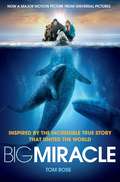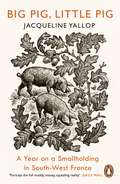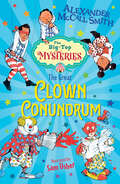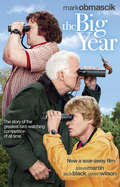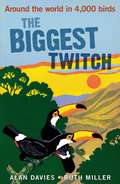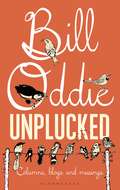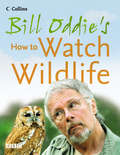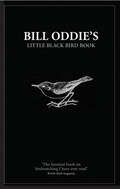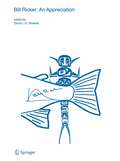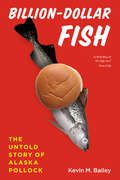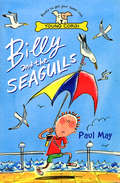- Table View
- List View
Big Game of Botswana: The Tragic History of a Once Great Southern African Fauna
by Clive SpinageQuoting contemporary accounts from hunters, missionaries and traders from the early nineteenth century onwards, this book illustrates the ecology of the country as it was emphasizing its rich large mammal fauna, its decline from increasing aridity of the country, it destruction by hunters, by disease, and most importantly, destruction of its vast herds, notably of wildebeest, due to the developing beef export economy and the erection of veterinary cordon fences depriving the large game of migration routes in times of drought. Once possessing one of the greatest animal displacements in Africa, with huge migrations of antelope, this book underlines the reality that the fauna of Botswana today is but a tiny remnant of what was perhaps once one of the the greatest spectacles of big game on earth. It shows how the decline came about -- and the controls exercised by tribal chiefs illustrating the indigenous peoples’ attitudes, and eventual protective measures both tribal and statutory. Whereas the pessimistic predictions of extinction at the end of the nineteenth century have happily not come true, nonetheless, the continued existence of this once great fauna is increasingly threatened by climate change threatening an already fragile balance, and human population increase with its increasing economic demands and changes in land use. The study fills a gap in the literature of African wildlife conservation and is distinctive by drawing upon a rich historical background.
Big Meg: The Story of the Largest, Fiercest and Most Mysterious Shark
by Tim Flannery Emma Flannery'Big Meg is big fun! It's packed to the gills with gobsmacking facts, insightful conjecture, and personal obs from two world-class scientists and explorers ... a megaladon of delight for any shark-lover!' - Sy Montgomery, author of The Soul of an Octopus'Tim Flannery scores again, diving into the murky myth-filled waters surrounding the world's biggest predator, and surfacing with a breathless true story stuffed with astounding facts and personal experience.' - Lucy Cooke, author of Bitch and The Unexpected Truth about Animals'If you are not already addicted to Tim Flannery's writing, discover him now.' - Jared Diamond, author of Collapse and Guns, Germs and Steel'Engagingly written and a real labour of love (down to the tiny fin at the bottom of each right hand page). Give this book to the wannabe palaeontologist in your life' - MAIL ON SUNDAY------------------------------------------------------------------------------Imagine a ferocious marine hunter up to twenty metres long, weighing twice as much as a humpback whale and ten times more than Tyrannosaurus rex. With jaws that can open two metres wide, crammed with 276 serrated fangs, it can bite down with the greatest force of any animal that has ever lived.This is the Megalodon, also known as 'the Bigtooth', and it swam in our waters three million years ago. Compared with the dinosaurs, wiped out 66 million years ago, this is but a stone's throw into our planet's shadowy past when monsters reigned. Yet the Megalodon has been largely absent from the fossil record, leaving behind only a smattering of teeth and vertebrae prized by collectors, its existence steeped in mystery... until now.Marking a milestone in palaeontology, Tim Flannery, celebrated environmentalist, zoologist and explorer, and his scientist daughter Emma, tell the story of the giant shark for the first time. Big Meg follows the quest to demystify the colossus that left Earth with barely a trace, reveals where and how it lived, and discusses the theories and haunting stories surrounding this ancient legendary creature, including that it may still stalk the deep...This is the biography of the ultimate apex predator - a vital piece of the great natural history of our planet - and a compelling exploration of its awesome grip on the human imagination today........................................................................................................................................................................................................................'Tim Flannery is the real thing: a man with a gift for lucid exposition, who can really make his subject come alive.' Literary Review'This man is a national treasure, and we should heed his every word' Sunday Telegraph
Big Miracle: Three Trapped Whales, One Small Town, A Big-Hearted Story of Hope
by Tom RoseIn October 1988 an Inuit hunter saw three grey whales trapped in the frozen Arctic ocean near Barrow, an isolated Alaskan outpost. They were working together to keep their blow hole open, the two adolescents caring for the weaker baby. It was a poignant sight. Filmed by a local television reporter, this tiny regional news story snowballed into a global media frenzy. In this gripping, insightful book Tom Rose describes how journalists poured into Barrow, all woefully ill equipped for the sub-zero temperatures, warming up on bootleg alcohol. As the locals cheerfully found ways to profit from the visitors, Greenpeace activist Cindy Lowry battled to mount an extraordinary rescue operation that would unite conservationists and oil companies, the Inuit and the military, President Reagan and the Kremlin. 'At times a marvellously funny story . . . Beneath the heartwarming aspect of the rescue are darker tales of human greed, and about the power television has acquired to set the agenda of the news' Washington Post 'Few novels could match the characters, plot and dramatic tension' Chicago Tribune
Big Pacific: Passionate, Voracious, Mysterious, Violent
by Rebecca TansleyThe Pacific Ocean covers one-third of Earth’s surface—more than all of the planet’s landmasses combined. It contains half of the world’s water, hides its deepest places, and is home to some of the most dazzling creatures known to science. The companion book to the spectacular five-part series on PBS produced by Natural History New Zealand, Big Pacific breaks the boundaries between land and sea to present the Pacific Ocean and its inhabitants as you have never seen them before.Illustrated in full color throughout, Big Pacific blends a wealth of stunning Ultra HD images with spellbinding storytelling to take you into a realm teeming with exotic life rarely witnessed up close—until now. The book is divided into four sections, each one focusing on an aspect of the Pacific. "Passionate Pacific" looks at the private lives of sea creatures, with topics ranging from the mating behaviors of great white sharks to the monogamy of wolf eels, while "Voracious Pacific" covers hunting and feeding. In "Mysterious Pacific," you will be introduced to the Pacific’s more extraordinary creatures, like the pufferfish and firefly squid, and explore some of the region’s eerier locales, like the turtle tombs of Borneo and the skull caves of Papua New Guinea. "Violent Pacific" examines the effects of events like natural disasters on the development of the Pacific Ocean’s geography and the evolution of its marine life.Providing an unparalleled look at a diverse range of species, locations, and natural phenomena, Big Pacific is truly an epic excursion to one of the world’s last great frontiers.Five-part series on PBS:Big Pacific will air Wednesdays on PBS, June 21-July 19, 2017
Big Pig, Little Pig: A Year on a Smallholding in South-West France
by Jacqueline YallopAs heard on BBC Radio 4's Book of the Week'A delightful and entertaining memoir' Woman and HomeWhen Jacqueline moves to south-west France with her husband, she embraces rural village life and buys two pigs to rear for slaughter. But as she gets to know the animals better, her English sentimentality threatens to get in the way and she begins to wonder if she can actually bring herself to kill them. This is a memoir about that fateful decision, but it's also about the ethics of meat eating in the modern age, and whether we should know, respect and even love the animals we eat. At its heart, this book is a love story, exploring the increasing attachment of the author for her particular pigs, and celebrating the enduring closeness of humans and pigs over the centuries.
Big Sky Mountain
by Alex MilwayAn exhilarating new series set in the great outdoors, from HOTEL FLAMINGO author Alex Milway Welcome to Big Sky Mountain: a home for everyone! Rosa has come from the city to live with Grandma Nan in the wilds of Big Sky Mountain. And what surprises are in store for her! Grandma Nan is not exactly an ordinary grandma, and Big Sky Mountain is like nowhere Rosa has dreamed about before. Grandma Nan lives in an old wooden cabin with Albert the moose and Little Pig the pygmy owl, and spends every day out on adventures. From canoeing down rapids to making friends with the local animals, life never stays still for long on Big Sky Mountain! Rosa has a lot to learn, and when unexpected visitors to the mountain cause a bit of a ruckus, can she rise to the challenge, and be the mountain girl Grandma Nan needs her to be?
The Big-Top Mysteries (The Big-Top Mysteries #2)
by Alexander McCall SmithRoll up! Roll up! For the second exciting instalment in The Big-Top Mysteries series, packed with all the fun of the circus and an intriguing new mystery to be solved …
The Big Year: A Tale Of Man, Nature, And Fowl Obsession
by Mark ObmascikEach year, hundreds of people set out across North America determined to set a new record in a spectacularly competitive event. Is it tennis? Golf? Racing? Poker perhaps? No, it's bird-watching, and a contest known as the Big Year - a grand, gruelling, expensive (and occasionally vicious) 365-day marathon to identify the most species.THE BIG YEAR is the rollicking chronicle of the 275,000-mile odyssey of three unlikely adventurers who take their bird-watching so seriously it nearly kills them. From Texas in pursuit of the Rufus-capped Warbler to British Columbia in search of Xantus' Hummingbird, these obsessive enthusiasts brave roasting deserts, storm-tossed oceans, infested swamps and disgruntled lions (not to mention some of the lumpiest hotel mattresses known to man) as they vie to become North America's number one bird-watcher in what would prove to be the biggest Big Year of them all...This captivating tour of human and avian nature, of courage and deceit, of passion and paranoia reveals the extremes to which Man will go to pursue his dreams, to conquer and to categorize...
The Biggest Twitch: Around the World in 4,000 birds
by Alan Davies Ruth MillerMost people dream of packing in their humdrum city life, selling up and heading off into the unknown for a life of adventure. For Ruth Miller and Alan Davies this dream became a reality, albeit with a twist; they decided to pack in their jobs, sell their house and take on the ultimate birder's challenge - to smash the world record for the numberof species seen in one calendar year.This book is the story of their great expedition, searching for birds from Ecuador to Ethiopia via Argentina, Australia and Arizona. We follow this birding odyssey as they rachet up the species and the stamps in their passports, sharing in amazing birding experiences such as monkey-hunting Harpy Eagles in the Brazilian rain forest, seedsnipes in the Peruvian highlands and lekking bustards in South Africa, all leading to the ultimate question - will they break the magic 4,000? Written in an accessible style, this book will be of great interest to birders, readers of travel literature, and to people who simply enjoy a good adventure!
The Biggest Twitch: Around the World in 4,000 birds
by Alan Davies Ruth MillerMost people dream of packing in their humdrum city life, selling up and heading off into the unknown for a life of adventure. For Ruth Miller and Alan Davies this dream became a reality, albeit with a twist; they decided to pack in their jobs, sell their house and take on the ultimate birder's challenge - to smash the world record for the numberof species seen in one calendar year.This book is the story of their great expedition, searching for birds from Ecuador to Ethiopia via Argentina, Australia and Arizona. We follow this birding odyssey as they rachet up the species and the stamps in their passports, sharing in amazing birding experiences such as monkey-hunting Harpy Eagles in the Brazilian rain forest, seedsnipes in the Peruvian highlands and lekking bustards in South Africa, all leading to the ultimate question - will they break the magic 4,000? Written in an accessible style, this book will be of great interest to birders, readers of travel literature, and to people who simply enjoy a good adventure!
Bilbo the Lifeguard Dog: A true story of friendship and heroism
by Steven JamiesonWarm, funny and moving; the perfect summer read. For fans of Arthur, Finding Gobi and Damien Lewis' A Dog Called Hope.When Steve Jamieson met Bilbo, a chocolate Newfoundland puppy, little did he know that the small bundle of fluff would grow to take up a huge space in his heart and change his life forever. The pair were inseparable, with Bilbo accompanying Steve to his job as head lifeguard of Sennen beach in Cornwall every day. With his webbed paws and thick, double layer of fur, Bilbo was an excellent swimmer and he was soon promoted to honorary lifeguard. He was even credited with saving the lives of three people.Word about Bilbo spread and fans flocked from miles around to meet the friendly giant. But Bilbo and Steve couldn't have foreseen the obstacles that life would throw at them. Together, they would have to gather every bit of their strength to fight for their livelihood. Warm, heartfelt and moving, Bilbo the Lifeguard Dog is a tale of heroism and friendship, and is one man's tribute to his extraordinary dog.
Bill Oddie Unplucked: Columns, Blogs and Musings
by Bill OddieBill Oddie has been the voice and face of birding broadcasting for more than three decades. Those of a certain age will fondly remember Bill as the shortest and hairiest of the trio of The Goodies, a popular and long-running comedy series that followed hot on the heels of Monty Python. After those heady days, Bill reinvented himself as the face (and voice) of mainstream birdwatching in Britain. He fronted television and radio programmes and wrote widely in the press on subjects close to his heart. Never one to shirk controversy, Bill's writings were always informative and entertaining.In this new book, Bill has compiled and expanded a collection of his recent published musings about birds and birdwatching, and the wildlife he has been fortunate to see on his many travels over the years. The collection covers a wide array of subjects, from a less than satisfactory press trip to the Galapgaos in the 1980s and recent disagreements with his London neighbours over the noisy squadrons of parakeets over their respective gardens, to encounters with Orcas in Argentina and Iceland, and with an invisible Tiger in India. Writing in his witty and inimitable style, Bill is sure to entertain and enthrall his many fans with this new book of thoughts and opinions on the world of natural history. The book is illustrated throughout with Bill's charming and comic line drawings.
Bill Oddie Unplucked: Columns, Blogs and Musings
by Bill OddieBill Oddie has been the voice and face of birding broadcasting for more than three decades. Those of a certain age will fondly remember Bill as the shortest and hairiest of the trio of The Goodies, a popular and long-running comedy series that followed hot on the heels of Monty Python. After those heady days, Bill reinvented himself as the face (and voice) of mainstream birdwatching in Britain. He fronted television and radio programmes and wrote widely in the press on subjects close to his heart. Never one to shirk controversy, Bill's writings were always informative and entertaining.In this new book, Bill has compiled and expanded a collection of his recent published musings about birds and birdwatching, and the wildlife he has been fortunate to see on his many travels over the years. The collection covers a wide array of subjects, from a less than satisfactory press trip to the Galapgaos in the 1980s and recent disagreements with his London neighbours over the noisy squadrons of parakeets over their respective gardens, to encounters with Orcas in Argentina and Iceland, and with an invisible Tiger in India. Writing in his witty and inimitable style, Bill is sure to entertain and enthrall his many fans with this new book of thoughts and opinions on the world of natural history. The book is illustrated throughout with Bill's charming and comic line drawings.
Bill Oddie’s How to Watch Wildlife
by Bill Oddie Stephen Moss Fiona PitcherA tie-in to the TV series, offering practical advice to beginners wanting to learn more about wildlife
Bill Oddie's Little Black Bird Book
by Bill Oddie'Bird-watchers are tense, competitive, selfish, shifty, dishonest, distrusting, boorish, pedantic, unsentimental, arrogant and – above all – envious'. So says Bill Oddie, and he should know!
Bill Ricker: An Appreciation (Developments in Environmental Biology of Fishes #24)
by David L. G. NoakesThis book is the first complete biography of one of the founders of fishery science, William Edwin (Bill) Ricker (1908 - 2001), immortalized in the Ricker Curve. This book combines Bill’s own recollections with contributions from those who knew him and worked with him as a colleague during his multifaceted career. In an article written shortly before his death, Bill gives his own account of his career and intellectual development.
Billion-Dollar Fish: The Untold Story of Alaska Pollock
by Kevin M. BaileyAlaska pollock is everywhere. If you’re eating fish but you don’t know what kind it is, it’s almost certainly pollock. Prized for its generic fish taste, pollock masquerades as crab meat in california rolls and seafood salads, and it feeds millions as fish sticks in school cafeterias and Filet-O-Fish sandwiches at McDonald’s. That ubiquity has made pollock the most lucrative fish harvest in America—the fishery in the United States alone has an annual value of over one billion dollars. But even as the money rolls in, pollock is in trouble: in the last few years, the pollock population has declined by more than half, and some scientists are predicting the fishery’s eventual collapse. In Billion-Dollar Fish, Kevin M. Bailey combines his years of firsthand pollock research with a remarkable talent for storytelling to offer the first natural history of Alaska pollock. Crucial to understanding the pollock fishery, he shows, is recognizing what aspects of its natural history make pollock so very desirable to fish, while at the same time making it resilient, yet highly vulnerable to overfishing. Bailey delves into the science, politics, and economics surrounding Alaska pollock in the Bering Sea, detailing the development of the fishery, the various political machinations that have led to its current management, and, perhaps most important, its impending demise. He approaches his subject from multiple angles, bringing in the perspectives of fishermen, politicians, environmentalists, and biologists, and drawing on revealing interviews with players who range from Greenpeace activists to fishing industry lawyers. Seamlessly weaving the biology and ecology of pollock with the history and politics of the fishery, as well as Bailey’s own often raucous tales about life at sea, Billion-Dollar Fish is a book for every person interested in the troubled relationship between fish and humans, from the depths of the sea to the dinner plate.
Billion-Dollar Fish: The Untold Story of Alaska Pollock
by Kevin M. BaileyAlaska pollock is everywhere. If you’re eating fish but you don’t know what kind it is, it’s almost certainly pollock. Prized for its generic fish taste, pollock masquerades as crab meat in california rolls and seafood salads, and it feeds millions as fish sticks in school cafeterias and Filet-O-Fish sandwiches at McDonald’s. That ubiquity has made pollock the most lucrative fish harvest in America—the fishery in the United States alone has an annual value of over one billion dollars. But even as the money rolls in, pollock is in trouble: in the last few years, the pollock population has declined by more than half, and some scientists are predicting the fishery’s eventual collapse. In Billion-Dollar Fish, Kevin M. Bailey combines his years of firsthand pollock research with a remarkable talent for storytelling to offer the first natural history of Alaska pollock. Crucial to understanding the pollock fishery, he shows, is recognizing what aspects of its natural history make pollock so very desirable to fish, while at the same time making it resilient, yet highly vulnerable to overfishing. Bailey delves into the science, politics, and economics surrounding Alaska pollock in the Bering Sea, detailing the development of the fishery, the various political machinations that have led to its current management, and, perhaps most important, its impending demise. He approaches his subject from multiple angles, bringing in the perspectives of fishermen, politicians, environmentalists, and biologists, and drawing on revealing interviews with players who range from Greenpeace activists to fishing industry lawyers. Seamlessly weaving the biology and ecology of pollock with the history and politics of the fishery, as well as Bailey’s own often raucous tales about life at sea, Billion-Dollar Fish is a book for every person interested in the troubled relationship between fish and humans, from the depths of the sea to the dinner plate.
Billion-Dollar Fish: The Untold Story of Alaska Pollock
by Kevin M. BaileyAlaska pollock is everywhere. If you’re eating fish but you don’t know what kind it is, it’s almost certainly pollock. Prized for its generic fish taste, pollock masquerades as crab meat in california rolls and seafood salads, and it feeds millions as fish sticks in school cafeterias and Filet-O-Fish sandwiches at McDonald’s. That ubiquity has made pollock the most lucrative fish harvest in America—the fishery in the United States alone has an annual value of over one billion dollars. But even as the money rolls in, pollock is in trouble: in the last few years, the pollock population has declined by more than half, and some scientists are predicting the fishery’s eventual collapse. In Billion-Dollar Fish, Kevin M. Bailey combines his years of firsthand pollock research with a remarkable talent for storytelling to offer the first natural history of Alaska pollock. Crucial to understanding the pollock fishery, he shows, is recognizing what aspects of its natural history make pollock so very desirable to fish, while at the same time making it resilient, yet highly vulnerable to overfishing. Bailey delves into the science, politics, and economics surrounding Alaska pollock in the Bering Sea, detailing the development of the fishery, the various political machinations that have led to its current management, and, perhaps most important, its impending demise. He approaches his subject from multiple angles, bringing in the perspectives of fishermen, politicians, environmentalists, and biologists, and drawing on revealing interviews with players who range from Greenpeace activists to fishing industry lawyers. Seamlessly weaving the biology and ecology of pollock with the history and politics of the fishery, as well as Bailey’s own often raucous tales about life at sea, Billion-Dollar Fish is a book for every person interested in the troubled relationship between fish and humans, from the depths of the sea to the dinner plate.
Billion-Dollar Fish: The Untold Story of Alaska Pollock
by Kevin M. BaileyAlaska pollock is everywhere. If you’re eating fish but you don’t know what kind it is, it’s almost certainly pollock. Prized for its generic fish taste, pollock masquerades as crab meat in california rolls and seafood salads, and it feeds millions as fish sticks in school cafeterias and Filet-O-Fish sandwiches at McDonald’s. That ubiquity has made pollock the most lucrative fish harvest in America—the fishery in the United States alone has an annual value of over one billion dollars. But even as the money rolls in, pollock is in trouble: in the last few years, the pollock population has declined by more than half, and some scientists are predicting the fishery’s eventual collapse. In Billion-Dollar Fish, Kevin M. Bailey combines his years of firsthand pollock research with a remarkable talent for storytelling to offer the first natural history of Alaska pollock. Crucial to understanding the pollock fishery, he shows, is recognizing what aspects of its natural history make pollock so very desirable to fish, while at the same time making it resilient, yet highly vulnerable to overfishing. Bailey delves into the science, politics, and economics surrounding Alaska pollock in the Bering Sea, detailing the development of the fishery, the various political machinations that have led to its current management, and, perhaps most important, its impending demise. He approaches his subject from multiple angles, bringing in the perspectives of fishermen, politicians, environmentalists, and biologists, and drawing on revealing interviews with players who range from Greenpeace activists to fishing industry lawyers. Seamlessly weaving the biology and ecology of pollock with the history and politics of the fishery, as well as Bailey’s own often raucous tales about life at sea, Billion-Dollar Fish is a book for every person interested in the troubled relationship between fish and humans, from the depths of the sea to the dinner plate.
Billion-Dollar Fish: The Untold Story of Alaska Pollock
by Kevin M. BaileyAlaska pollock is everywhere. If you’re eating fish but you don’t know what kind it is, it’s almost certainly pollock. Prized for its generic fish taste, pollock masquerades as crab meat in california rolls and seafood salads, and it feeds millions as fish sticks in school cafeterias and Filet-O-Fish sandwiches at McDonald’s. That ubiquity has made pollock the most lucrative fish harvest in America—the fishery in the United States alone has an annual value of over one billion dollars. But even as the money rolls in, pollock is in trouble: in the last few years, the pollock population has declined by more than half, and some scientists are predicting the fishery’s eventual collapse. In Billion-Dollar Fish, Kevin M. Bailey combines his years of firsthand pollock research with a remarkable talent for storytelling to offer the first natural history of Alaska pollock. Crucial to understanding the pollock fishery, he shows, is recognizing what aspects of its natural history make pollock so very desirable to fish, while at the same time making it resilient, yet highly vulnerable to overfishing. Bailey delves into the science, politics, and economics surrounding Alaska pollock in the Bering Sea, detailing the development of the fishery, the various political machinations that have led to its current management, and, perhaps most important, its impending demise. He approaches his subject from multiple angles, bringing in the perspectives of fishermen, politicians, environmentalists, and biologists, and drawing on revealing interviews with players who range from Greenpeace activists to fishing industry lawyers. Seamlessly weaving the biology and ecology of pollock with the history and politics of the fishery, as well as Bailey’s own often raucous tales about life at sea, Billion-Dollar Fish is a book for every person interested in the troubled relationship between fish and humans, from the depths of the sea to the dinner plate.
Billion-Dollar Fish: The Untold Story of Alaska Pollock
by Kevin M. BaileyAlaska pollock is everywhere. If you’re eating fish but you don’t know what kind it is, it’s almost certainly pollock. Prized for its generic fish taste, pollock masquerades as crab meat in california rolls and seafood salads, and it feeds millions as fish sticks in school cafeterias and Filet-O-Fish sandwiches at McDonald’s. That ubiquity has made pollock the most lucrative fish harvest in America—the fishery in the United States alone has an annual value of over one billion dollars. But even as the money rolls in, pollock is in trouble: in the last few years, the pollock population has declined by more than half, and some scientists are predicting the fishery’s eventual collapse. In Billion-Dollar Fish, Kevin M. Bailey combines his years of firsthand pollock research with a remarkable talent for storytelling to offer the first natural history of Alaska pollock. Crucial to understanding the pollock fishery, he shows, is recognizing what aspects of its natural history make pollock so very desirable to fish, while at the same time making it resilient, yet highly vulnerable to overfishing. Bailey delves into the science, politics, and economics surrounding Alaska pollock in the Bering Sea, detailing the development of the fishery, the various political machinations that have led to its current management, and, perhaps most important, its impending demise. He approaches his subject from multiple angles, bringing in the perspectives of fishermen, politicians, environmentalists, and biologists, and drawing on revealing interviews with players who range from Greenpeace activists to fishing industry lawyers. Seamlessly weaving the biology and ecology of pollock with the history and politics of the fishery, as well as Bailey’s own often raucous tales about life at sea, Billion-Dollar Fish is a book for every person interested in the troubled relationship between fish and humans, from the depths of the sea to the dinner plate.
Billion-Dollar Fish: The Untold Story of Alaska Pollock
by Kevin M. BaileyAlaska pollock is everywhere. If you’re eating fish but you don’t know what kind it is, it’s almost certainly pollock. Prized for its generic fish taste, pollock masquerades as crab meat in california rolls and seafood salads, and it feeds millions as fish sticks in school cafeterias and Filet-O-Fish sandwiches at McDonald’s. That ubiquity has made pollock the most lucrative fish harvest in America—the fishery in the United States alone has an annual value of over one billion dollars. But even as the money rolls in, pollock is in trouble: in the last few years, the pollock population has declined by more than half, and some scientists are predicting the fishery’s eventual collapse. In Billion-Dollar Fish, Kevin M. Bailey combines his years of firsthand pollock research with a remarkable talent for storytelling to offer the first natural history of Alaska pollock. Crucial to understanding the pollock fishery, he shows, is recognizing what aspects of its natural history make pollock so very desirable to fish, while at the same time making it resilient, yet highly vulnerable to overfishing. Bailey delves into the science, politics, and economics surrounding Alaska pollock in the Bering Sea, detailing the development of the fishery, the various political machinations that have led to its current management, and, perhaps most important, its impending demise. He approaches his subject from multiple angles, bringing in the perspectives of fishermen, politicians, environmentalists, and biologists, and drawing on revealing interviews with players who range from Greenpeace activists to fishing industry lawyers. Seamlessly weaving the biology and ecology of pollock with the history and politics of the fishery, as well as Bailey’s own often raucous tales about life at sea, Billion-Dollar Fish is a book for every person interested in the troubled relationship between fish and humans, from the depths of the sea to the dinner plate.
Bill's Clinical Pharmacology and Therapeutics for Veterinary Technicians - E-Book: Bill's Clinical Pharmacology and Therapeutics for Veterinary Technicians - E-Book
by Melinda Anderson**Selected for Doody's Core Titles® 2024 in Veterinary Nursing & Technology** Build the skills you need to use drugs safely and avoid potential problems! Trusted by vet techs for 30 years, Bill's Clinical Pharmacology and Therapeutics for Veterinary Technicians helps you understand the principles and practice of pharmacology in treating different animal species. The text explains how drugs work, how they are administered, and how to calculate drug dosages. Covering drugs by body system, the book also explains possible abuses, mistakes, and how things can go wrong when therapeutic protocols are not properly implemented. From veterinary pharmacist and educator Melinda "Mindy" Anderson, this fifth edition helps you provide better care for your patients and better education for their owners. - Content on basic pharmacology includes topics such as safety, terminology, pharmacy procedures, drug handling (including the latest OSHA requirements), dosage calculations, and pharmacokinetics. - Chapter outlines, learning objectives, and key terms are provided at the beginning of each chapter, introducing you to the complex principles of pharmacology and guiding your study. - Clear explanations of drugs help you understand the "how" and "why" behind drugs, their actions, their mechanisms, and adverse effects. - Myths and Misconceptions, Ask Dr. Bill, and You Need to Know boxes spotlight key issues, concepts, and skills. - Clinical applications link pharmacologic concepts to real-life situations. - Review questions and critical thinking questions are included at the end of every chapter to help readers test their comprehension. - Test questions and online quizzes enable self-assessment and help you prepare for classroom and certification exams. - NEW Veterinary Feed Directives section reflects the newest FDA guidelines on medicated feed for animals. - NEW! Updated drug information includes all drug categories as well as new information on several drugs. - NEW! Additional full-color images make it easier to understand pharmacology concepts. - NEW! Updated test questions and drug calculation exercises on the Evolve website make study and review easier and reinforce your understanding of difficult subject matter.
Billy And The Seagulls
by Mr Paul MayEddie's little brother Billy is terrified of everything! Snakes, the dark, toilets, orange peel, moustaches and even soggy toast. When they move to the seaside, Billy find a new thing to be scared of - seagulls! They swoop down in the playground and pick at leftover crisp packets - and Billy thinks they are the scariest thing he has ever seen. Can Eddie and his stepfather try to work out ways to help Billy get over his fears?


